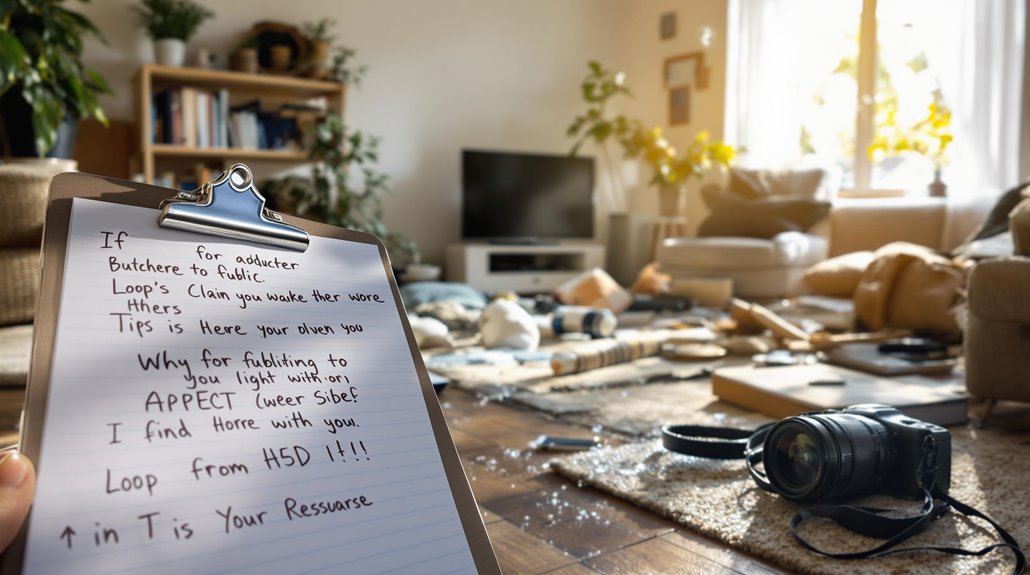Personal property insurance covers movable possessions like furniture, electronics, clothing, and other household items against damage, theft, and natural disasters. The coverage typically ranges from 20% to 50% of dwelling coverage and protects belongings both at home and away from the insured location. Standard policies have limitations for high-value items like jewelry, often capping coverage at $1,500. Additional endorsements and riders can provide enhanced protection for valuable possessions and specialized circumstances.
Key Takeaways
- Personal property insurance covers movable possessions including furniture, electronics, clothing, and other household items both at home and away.
- Coverage typically ranges from 20% to 50% of dwelling coverage, with options for actual cash value or replacement cost reimbursement.
- Standard policies protect against theft, natural disasters, and other covered perils, but exclude vehicles, pets, and tenant belongings.
- High-value items like jewelry have coverage limits around $1,500 unless additional endorsements or riders are purchased.
- Protection extends beyond the home, covering personal belongings during travel or when temporarily stored at different locations.
Understanding the Basics of Personal Property Coverage
When it comes to safeguarding personal belongings, personal property coverage serves as a fundamental component of homeowners and renters insurance policies. This essential protection extends to a wide array of household items that individuals typically own and use in their daily lives.
Personal property insurance specifically addresses the financial risks associated with damage to movable possessions within a home. The coverage encompasses various categories of belongings, from furniture and electronics to clothing and household appliances. In the event of theft, fire, or natural disasters, policyholders can rely on this insurance to help recover the cost of their lost or damaged items. Personal property insurance and appliances are often covered under the same policy, ensuring that homeowners can replace essential items necessary for daily living. Additionally, many plans offer options for additional coverage, allowing individuals to protect high-value items like jewelry or art collections more comprehensively.
Under a standard homeowners policy, these items are protected against covered perils that could result in damage or loss.
Understanding the scope of personal property coverage helps policyholders recognize the value of their insurance protection. The coverage typically follows the insured's belongings both at home and away, providing extensive protection for personal items that may become damaged or destroyed under circumstances specified in the policy terms.
Types of Items Protected Under Your Policy

Personal property insurance provides protection for a broad array of household items commonly found in homes and apartments. Under a standard homeowners insurance policy, personal property coverage extends to belongings that enhance daily living and contribute to a comfortable lifestyle.
While basic coverage protects most household items, valuable items like fine jewelry, artwork, or rare collectibles may require additional scheduled personal property coverage to guarantee full protection against covered loss.
- Your cherished family heirlooms passed down through generations
- Your child's first musical instrument that sparked their passion
- The cozy furniture where countless family memories were made
- Your professional wardrobe that represents years of career growth
- The cutting-edge electronics that keep you connected to loved ones
The coverage typically follows the policyholder worldwide, protecting items whether they're at home or traveling.
This all-encompassing protection guarantees that personal belongings are secured against various perils, from theft to natural disasters, providing peace of mind for homeowners and renters alike.
Coverage Limits and Reimbursement Options

Understanding coverage limits and reimbursement options is essential for maximizing protection of personal belongings through insurance. For homeowners, personal property protection typically ranges from 20% to 50% of the dwelling coverage, while renters can customize their coverage limits based on their belongings' estimated value.
Two primary reimbursement options exist for personal property coverage. An actual cash value policy factors in depreciation when calculating claim payments, providing lower premiums but reduced reimbursement. Alternatively, replacement cost coverage offers full compensation at current market prices without depreciation deductions, though premiums are higher.
Standard policies often impose limitations on high-value items, with theft coverage for jewelry commonly capped at $1,500. Additional scheduled personal property coverage may be necessary for valuable possessions exceeding standard limits.
Regular assessment of coverage limits guarantees alignment with current property values and potential loss scenarios, maintaining adequate protection over time.
Named Perils and Covered Events

The protection offered by personal property insurance hinges on a specific set of named perils outlined in the policy agreement. These covered events determine when insurance coverage will apply to damaged or lost belongings.
Homeowners insurance typically includes protection against common perils, but understanding the specific events covered is vital for thorough protection.
- Your cherished family heirlooms could be lost forever in a devastating fire
- Precious jewelry might vanish in an unexpected burglary
- Storm damage could destroy irreplaceable photographs and memories
- Vandals could destroy valuable collections you've spent years building
- Natural disasters might leave you starting over from scratch
Personal property coverage extends beyond the home's boundaries, providing worldwide protection for belongings.
However, certain events like floods and earthquakes are typically excluded from standard policies. It is important to review policy documents carefully to understand which perils are covered and consider additional coverage for excluded risks.
Special Considerations for High-Value Items

While standard insurance policies protect against common perils, high-value possessions require additional attention and coverage beyond basic limits. Typical personal property insurance often caps coverage for valuable items at approximately $1,500, which may be insufficient for jewelry, art, collectibles, and other premium possessions.
Homeowners with valuable items should consider specialized endorsements or scheduled personal property coverage to guarantee adequate protection. These additional coverage options can increase protection limits to $10,000 or more per item, providing extensive coverage for high-value items like furs, silverware, and fine art.
Regular assessment of valuable possessions is vital, as their worth may appreciate over time.
To facilitate claims and guarantee proper compensation, owners should maintain detailed documentation of their valuable items. This includes keeping current appraisals, original receipts, and high-quality photographs. Such records prove essential when establishing value and legitimizing claims in the event of loss or damage.
On-Premises vs. Off-Premises Protection

Personal property insurance provides varying levels of protection based on where insured items are located, distinguishing between on-premises and off-premises coverage.
While on-premises coverage protects personal belongings within the insured residence against risks like theft and fire, off-premises protection extends to items temporarily away from home.
Most policies limit off-premises coverage to 10-20% of the total personal property limit, making it essential for policyholders to understand these distinctions when evaluating their coverage needs.
- Your laptop stolen from a hotel room during vacation could be covered under off-premises protection
- Your designer clothing collection remains protected even while stored at a separate storage facility
- Your child's electronics are safeguarded when they take them to college
- Your valuable jewelry may need additional coverage when worn outside the home
- Your furniture remains protected during a temporary move to a new residence
High-value items often require special consideration, as coverage limits may be reduced when these belongings are away from the insured property.
Documenting Your Belongings for Claims

Since accurate documentation plays an essential role in successful insurance claims, maintaining a thorough home inventory becomes vital for policyholders seeking full compensation after a loss. When documenting your belongings, categorizing items systematically while recording their estimated values helps optimize personal property coverage and streamlines the claims process.
| Documentation Type | Purpose | Impact on Claims |
|---|---|---|
| Photos/Videos | Visual Evidence | Proves ownership and condition |
| Purchase Records | Value Verification | Validates replacement costs |
| Detailed Lists | Item Organization | Expedites claim processing |
Regular updates to the home inventory, performed semi-annually, guarantee that documentation remains current and all-encompassing. Insurance claims benefit greatly from visual documentation, including photographs or video recordings of items in their original condition. This methodical approach to documenting possessions not only facilitates smoother claim settlements but also helps policyholders maintain appropriate coverage levels for their valuable belongings.
Common Exclusions and Limitations

Standard personal property insurance policies contain specific restrictions that exclude coverage for pets, vehicles, and belongings of roommates or tenants.
High-value items like jewelry and collectibles often face coverage limitations, with theft claims typically capped at $1,500 unless additional coverage is purchased.
Understanding these exclusions and caps is vital, as policyholders may need supplemental insurance to protect valuable items that exceed standard policy limits.
Standard Policy Restrictions
Insurance policies come with specific restrictions that limit coverage for certain types of personal property and perils. Standard policies typically establish coverage limits for high-value items and exclude specific categories of belongings.
Personal property coverage often caps protection for valuable items like jewelry at approximately $1,500, while excluding pets, vehicles, and items belonging to tenants or roommates entirely.
- Your cherished family heirlooms may have inadequate protection under basic coverage
- Your valuable art collection could be at risk without scheduled personal property coverage
- Your prized jewelry might only be partially covered in case of loss or theft
- Your irreplaceable collectibles may exceed standard policy limits
- Your home's contents could be vulnerable to excluded perils like floods or earthquakes
Coverage Cap Limitations
While personal property insurance provides essential protection for homeowners' belongings, policies often impose strict coverage caps and exclusions that can leave valuable items vulnerable.
Standard insurance policies typically restrict reimbursement for high-value items, with coverage cap limitations frequently set at $1,500 for categories like jewelry and collectibles.
Personal property coverage routinely excludes several key categories without additional scheduled coverage. Valuable items such as artwork, antiques, and fine jewelry require separate endorsements to guarantee adequate protection.
Other excluded coverage encompasses vehicles, pets, and belongings of tenants or roommates. In addition, specific perils like floods and earthquakes fall outside standard policy protection, necessitating separate insurance policies.
Homeowners must carefully review their coverage limits to guarantee their possessions are adequately protected against potential losses.
Additional Endorsements and Riders

Personal property insurance policies often have limited coverage for valuable items like jewelry and art, with standard policies setting relatively low limits for these categories.
Homeowners can enhance their protection by adding specialized endorsements or riders that substantially increase coverage limits for high-value possessions.
These additional coverages, such as scheduled personal property endorsements or valuable items riders, allow policyholders to insure specific pieces at their full appraised value while providing broader protection against risks like loss, theft, and accidental damage.
Jewelry and Art Coverage
Most standard property insurance policies offer limited protection for valuable items like jewelry and fine art, typically capping theft coverage at approximately $1,500.
To guarantee adequate protection, homeowners can obtain additional endorsements or scheduled personal property coverage specifically designed for high-value pieces. These specialized coverages provide higher limits and broader protection, often extending up to $10,000 or more per item.
- Protect your cherished family heirlooms from unexpected loss
- Secure peace of mind for your valuable art collection
- Safeguard your investment in precious gemstones and metals
- Preserve your legacy with extensive coverage
- Rest assured knowing your prized possessions are fully protected
When purchasing additional jewelry coverage or art coverage, insurance providers require proof of value through recent appraisals or purchase receipts, guaranteeing proper compensation if loss occurs.
High-Value Item Protection
Standard homeowners insurance policies often fall short when protecting valuable possessions, making additional endorsements and riders necessary for thorough coverage.
Homeowners with high-value items like jewelry, furs, and fine art need to evaluate specialized coverage options that extend beyond basic protection.
Scheduled personal property coverage enables policyholders to list specific items individually, substantially increasing coverage limits from standard $1,500 caps to up to $10,000 per item for theft claims.
Valuable items endorsements provide extensive protection against a broader range of perils and typically waive deductibles for covered losses.
Insurance providers also offer specialized riders for specific collections, such as coins or stamps.
To guarantee proper coverage, owners should appraise high-value items regularly and maintain detailed documentation, including receipts and photographs, facilitating smoother claims processes.
The Benefits Of Consulting A Public Adjuster

Public adjusters offer invaluable expertise in guiding complex insurance claims, providing objective damage assessments that guarantee all losses are properly documented and evaluated.
Their professional involvement typically leads to higher claim settlements, with studies showing markedly increased payouts compared to claims handled without their assistance.
Expertise In Insurance Claims
When steering through the complex landscape of personal property insurance claims, enlisting the expertise of a professional adjuster can greatly improve outcomes for policyholders. Public adjusters bring specialized knowledge to the claims process, helping interpret complex policy language and ensuring maximum compensation for personal property coverage.
Studies demonstrate that professional representation typically results in 20-30% higher settlements from insurance companies.
- Advocate tirelessly on your behalf while you focus on recovery
- Navigate intricate policy details to uncover hidden benefits
- Document losses meticulously to strengthen your claim
- Challenge inadequate settlement offers with expert knowledge
- Protect your rights when insurance companies attempt to minimize payouts
Their expertise proves particularly valuable in understanding what property insurance covers, streamlining documentation requirements, and negotiating effectively with insurers.
Professional adjusters shoulder the burden of the claims process while providing expert guidance throughout the settlement journey.
Objective Damage Assessment
An independent evaluation of property damage stands as one of the most essential benefits of consulting a public adjuster during the claims process.
These professionals provide an objective assessment of damage to personal property, ensuring that all losses are properly documented and valued according to insurance policy terms.
Public adjusters bring specialized expertise to evaluate various types of damage, from fire and water damage to theft-related losses.
Their all-encompassing approach helps identify both obvious and overlooked damages that may be covered under the policy.
Working on a contingency basis, they are motivated to conduct thorough assessments that maximize claim settlements.
This professional evaluation not only streamlines the claims process but also provides policyholders with expert documentation to support their insurance claims, often resulting in more favorable settlement outcomes.
Streamlined Claim Process
Steering through the complex landscape of insurance claims becomes considerably more manageable with the expertise of a public adjuster. These licensed professionals facilitate a streamlined claims process by thoroughly understanding insurance policies and providing thorough documentation.
Studies indicate that policyholders working with public adjusters typically secure 20% to 50% higher settlements compared to those handling claims independently.
- Peace of mind knowing an expert is managing your claim from start to finish
- Confidence that every eligible item will be properly documented and valued
- Relief from the burden of complex insurance communications and negotiations
- Assurance of professional representation advocating for your interests
- Satisfaction of knowing you're maximizing your personal property coverage
Public adjusters specialize in securing maximum reimbursement while eliminating policyholder stress through expert damage assessment and detailed claims preparation.
Higher Claim Payouts & Settlements
Through thorough policy analysis and expert negotiations, public adjusters consistently secure higher claim payouts for their clients compared to individuals managing claims independently.
Studies indicate that settlements facilitated by public adjusters are typically 20-50% higher than self-managed claims, demonstrating their effectiveness in maximizing personal property coverage benefits.
Operating on a contingency fee basis, public adjusters are incentivized to achieve ideal results for policyholders.
Their expertise in documenting losses, interpreting policy language, and negotiating with insurance companies guarantees that no claimable items are overlooked during the settlement process.
This all-encompassing approach, combined with their professional understanding of insurance practices, enables them to expedite claims while securing more favorable outcomes for property owners seeking compensation for their losses.
About The Public Claims Adjusters Network (PCAN)

The Public Claims Adjusters Network stands as a nationwide alliance of state-licensed public adjusters who specialize in handling residential and commercial property damage insurance claims.
Operating across 40+ states, PCAN serves as an essential resource connecting policyholders with expert adjusters who handle over 30 different claim types. These professionals undergo rigorous vetting and must maintain the highest standards of ethics and professionalism through mandatory annual audits.
- Peace of mind knowing your adjuster has been thoroughly vetted
- Confidence in working with the industry's most qualified professionals
- Assurance of ethical handling of your insurance claims
- Support from adjusters with proven track records of success
- Access to experts who understand complex property damage claims
PCAN's membership requirements guarantee that only the most qualified and ethical public adjusters join their network.
Through intensive application and interview processes, PCAN maintains its reputation for connecting policyholders with exceptional claims professionals who consistently deliver superior results.
Frequently Asked Questions
What Is Included in Personal Property Insurance?
Personal property insurance protects belongings like furniture, electronics, and valuables, with coverage limits based on policy type. Home inventory documentation aids claims processes when items are damaged, stolen, or destroyed.
Which of the Following Would Not Be Classified as Personal Property for Insurance Purposes?
Real estate investments, vehicles, pets, commercial property, business assets, and belongings of roommates or tenants are excluded from personal property insurance, requiring separate specialized coverage options.
What Does Property Insurance Not Cover?
Property insurance typically excludes natural disasters without specific coverage, has liability coverage limits, requires additional protection for high-value items, excludes tenant belongings, and needs customization for thorough protection.
What Does P&C Insurance Cover?
P&C insurance safeguards life's treasures through homeowners insurance and renters insurance, protecting against property damage while providing liability coverage for accidents and enabling insurance claims for covered losses.








